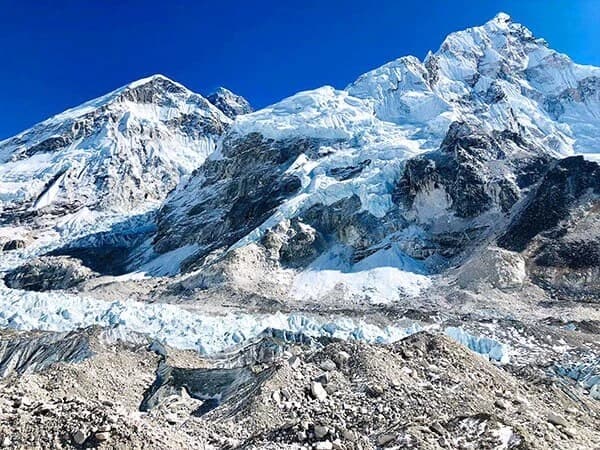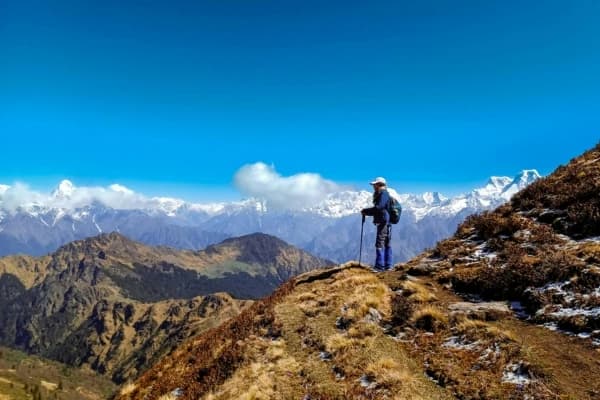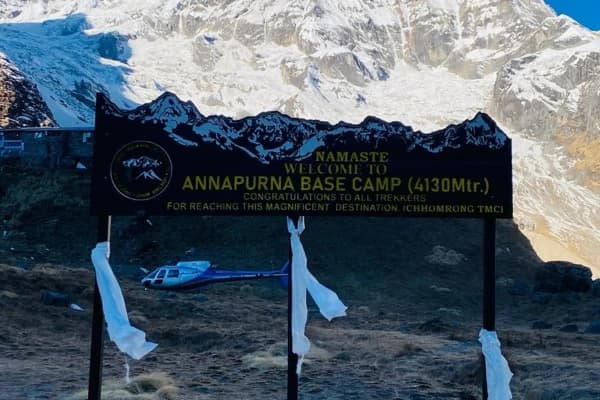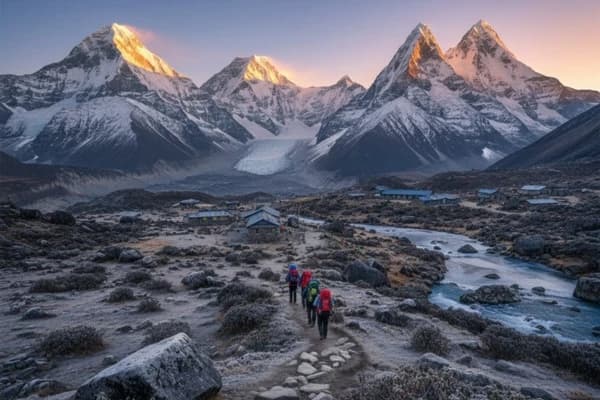Everest Base Camp sits high in Nepal’s Sagarmatha National Park, at over 5,300 meters above sea level. It’s the starting point for climbers aiming to reach the summit of Mount Everest, the tallest mountain on Earth.
The trek to Everest Base Camp is a journey like no other, winding through charming Sherpa villages, lush forests, and rugged mountain terrain. Most trekkers begin with a thrilling flight from Kathmandu to Lukla, then hike through bustling towns like Namche Bazaar and visit sacred sites such as Tengboche Monastery.
Along the way, the stunning views of towering peaks and the chance to experience local culture make this trek truly unforgettable. Many also take the extra climb to Kala Patthar, a spot famous for its jaw-dropping sunrise views over Everest.
Why Trek to EBC in November?
November is one of the best months to take on this Everest Base Camp Trek. The weather is usually dry and stable, with clear blue skies that offer some of the most spectacular mountain views you’ll ever see. Daytime temperatures are comfortable for hiking, though it gets quite chilly at night, especially as you climb higher, so packing warm layers is key. The trails are a bit quieter than in October, giving you a more peaceful experience.
Additionally, if you're lucky, you might be able to attend the vibrant Mani Rimdu festival, a unique Sherpa celebration that is packed with dances and customs that give your journey a deeper cultural dimension. All things considered, November provides the ideal balance of fantastic weather, breathtaking landscapes, and cultural experiences that make the Everest Base Camp climb genuinely unforgettable.
Trek Everest this November with Nepal Gateway Trekking for clear skies, rich culture, and expert-guided adventure. Book now for an unforgettable journey!
Everest Base Camp Trek Weather in November

November is the tail-end of the autumn season in Nepal. The monsoon is long gone, and winter is just around the corner, making it the perfect in-between time to trek.
What’s the weather like?
- Daytime temperatures: 10°C to 15°C (in lower altitudes)
- Nighttime temperatures: Can drop below freezing (-5°C to -10°C at higher altitudes)
- Rain: Very little or none
- Visibility: Crystal clear!
November is the tail-end of the autumn season in Nepal. The monsoon is long gone, and winter is just beginning to set in, bringing crisp air and clear mountain views.
| Location | Elevation | Avg Temp (in Celsius) | Min Temp | Max Temp |
| Lukla | 2,829 m | 6.5 | 0.9 | 12.2 |
| Namche | 3,463 m | 2.9 | -3.4 | 9.2 |
| Dingboche | 4,483 m | -2.9 | -11 | 5.3 |
| Lobuche | 4,910 m | -5.5 | -13.8 | 2.8 |
| Gorak Shep | 5,180 m | -6.6 | -14.9 | 1.8 |
Note: Because high-altitude weather can change quickly, especially in late November, be ready for unexpected dips in temperature as well as the possibility of snow or blizzards.
5 Most Recommended Trekking Routes to Everest Base Camp in November
November is one of the best months to trek to Everest Base Camp, with clear skies, stable weather, and dry trails making all major routes accessible and enjoyable. Here are some popular trekking options to consider:
1. Classic Everest Base Camp Trek
Beginning at Lukla, the Classic Everest Base Camp Trek is the most well-traveled route that passes through Sherpa communities, Buddhist monasteries, and breathtaking scenery. Enjoy the magnificent views of Everest and the surrounding peaks as you go via Namche Bazaar, Tengboche Monastery, and eventually to the Base Camp.
2. Gokyo Valley and Renjo La Pass Trek
The Gokyo Valley trek with the Renjo La Pass offers breathtaking blue lakes and expansive mountain views for hikers looking for a less-traveled and more challenging route. Because of the consistent weather in November, all passes are accessible and safe.
3. Jiri to Everest Base Camp Trek
Starting from Jiri by road, this longer route offers a traditional trekking experience with more time to acclimatize and fewer crowds. It’s perfect for those wanting to avoid the busy Lukla flights and explore remote villages.
4. Everest Base Camp Helicopter Trek
The Everest Base Camp helicopter excursion offers breathtaking aerial views of the Everest region with little physical effort, making it ideal for anyone who is pressed for time or who wants a more opulent experience. November is the perfect month for these tours because of its gorgeous skies.
5. Everest Three Passes Trek
For experienced trekkers seeking a challenge, this route covers three high passes—Renjo La, Cho La, and Kongma La—offering breathtaking views and a rich cultural immersion. November’s clear weather and stable trails make this demanding trek feasible and spectacular for Everest high Passes Trek.
Want a trek that matches your pace and preferences? Customize your trips with Nepal Gateway Trekking — your journey, your way. Let’s plan the perfect route together!
Accommodation and Food Facilities on the Everest Base Camp Trek in November
There are many lodging alternatives along the Everest Base Camp trek in November, but because it's still part of the peak trekking season, preparation is key to a successful trip.
Here’s what to expect
- Most teahouses and lodges are open and ready to welcome trekkers.
- Booking your accommodation in advance is strongly advised.
- Tea houses provide simple, comfortable rooms with basic amenities like warm bedding and shared bathrooms.
- Hot meals and warm drinks are served daily to help you recharge.
- Expect busy meal times; pre-ordering food can save time.
Note: Nights can be very cold, so a good sleeping bag is a must!
What About the Cold?
Let’s not sugarcoat it — it does get cold at night. But with the right gear, you’ll be fine.
What to pack
- Thermal base layers
- Down jacket
- Warm hat and gloves
- Waterproof hiking boots
- Sleeping bag rated for -10°C or colder
Safety and Trail Conditions
The trail is dry and stable, which is safer than slippery monsoon paths. There’s also less risk of altitude sickness if you pace yourself and follow a proper itinerary.
Nepal Gateway Trekking Travel guides provides full information and porter and guides are trained in first aid and altitude care. You’ll be in good hands from start to finish.
Is November the Best Time for Everest Base Camp Trek?
Yes, it’s one of the best months of the year to trek to EBC! Here’s why November is ideal:
- Dry weather
- Clear mountain views
- Fewer people
- Active teahouses
- Great photography conditions
But if you’re someone who hates the cold, early October or spring (April–May) might suit you better.
Essential Packing List for Everest Base Camp Trek in November

In order to ensure a safe and comfortable trip to Everest Base Camp in November, the right gear and attire need to be ready.
Particularly at higher elevations, the weather can be cold, so it's crucial to pack sensibly and layer. Here is a brief list of items you will need for the hike:
Clothing
- Moisture-wicking base layers (long-sleeve and short-sleeve)
- Mid-layer insulators like down coats or fleece
- The outer shell of the jacket and pants is waterproof and windproof.
- Thermal underwear for cold nights
- Warm gloves (insulated and waterproof) and glove liners
- Wool or fleece hat, and sun hat or cap
- Trekking pants and warm fleece pants
- Hiking socks (multiple pairs, including wool or merino)
- Comfortable trekking boots (well broken-in and waterproof)
- Camp shoes or sandals for lodges
Trekking Gear
- Durable backpack (30-40 liters for daypack)
- Duffel bag for porter (if using)
- Trekking poles for stability
- Sleeping bag rated for sub-zero temperatures (0°F/-18°C recommended)
- Headlamp with extra batteries
- Water bottles or hydration bladder (at least 2 liters capacity)
- Sunglasses with UV protection and sunscreen
Personal Items and Extras
- Toiletries including biodegradable soap, toothbrush, toothpaste, and wet wipes
- Lip balm with SPF
- Hand sanitizer
- Small first aid kit (including altitude sickness medication)
- Snacks like energy bars and nuts
- Camera or a smartphone for photos
- Travel documents, permits, and insurance papers
Tips from the Experts of NGT
- Pack light but smart—carry only essentials in your daypack.
- Layer your clothing to adapt to changing temperatures.
- Prepare for cold nights by bringing extra warm layers and a good sleeping bag.
- Use quality gear to ensure durability and comfort on the trail.
This packing list will help you stay comfortable and safe during your Everest Base Camp trek in November, making your adventure more enjoyable and memorable. Nepal Gateway Trekking has prepared equipment checklist to make your trek easier.
What Festivals Are Celebrated During the Everest Base Camp Trek in November?

Important cultural celebrations like the Mani Rimdu Festival and Tihar, as well as sporadic Sherpa customs and the conclusion of Dashain, are available to trekkers to Everest Base Camp in November. These celebrations provide a singular window into the rich spiritual and cultural legacy of the area.
Cultural Festivals in November
Trekking in November gives you a chance to witness rich Himalayan culture and celebrations. Here are a few:
Mani Rimdu Festival
- Held at Tengboche Monastery
- Features masked dances and rituals by Buddhist monks
- Celebrates the victory of good over evil
Tihar (Festival of Lights)
- Celebrates animals like dogs and cows
- Includes lights, colors, and Bhai Tika for siblings
Dashain (Ending Phase)
- May stretch into early November
- Nepal’s biggest festival, honoring family and traditions
Local Sherpa Rituals
- Ongoing spiritual and community ceremonies
- Add a deeper meaning to your trek
These cultural events make your Everest Base Camp trek in November even more memorable! These festivals augment the Everest Base Camp journey in November by combining spectacular scenery with lively cultural events.
Safety Tips and Travel Insurance for the Everest Base Camp Trek in November
- Acclimatization: To prevent illness, give yourself time to get used to the higher altitude.
- Layering: To adjust to shifting temperatures, wear layers.
- Hydration: To stay hydrated, drink a lot of water.
- Travel insurance is necessary to protect against the risks of high-altitude trekking, including emergency evacuation.
- Start Early: To make the most of daylight and prevent weather changes in the afternoon, start your walk early every day.
Wrapping Up
The Everest Base Camp trek with Nepal Gateway Trekking promises to be a once-in-a-lifetime experience full of stunning landscapes, a vibrant culture, and amazing camaraderie. November is without a doubt the best month to take in the splendor of the Himalayas because of the clear skies, consistent weather, and vibrant local celebrations.
Ready to Trek Everest Base Camp in November?
If you want clear views, peaceful trails, and the real Himalayan experience, then November is your golden ticket. It’s a time when Everest shines the brightest, and nature rewards every step you take.
Book your Everest Base Camp trek in November with Nepal Gateway Trekking today — let’s make your mountain dream come true!
Questions Trekker’s Asked About the Everest Base Camp Trek in November
When is the best time for the Everest Base Camp trek in Nepal?
The best time for trekking to Everest Base Camp in Nepal is during the pre-monsoon (March to May) and post-monsoon (late September to November) seasons.
Is November a good month for the Everest Base Camp trek?
Yes, November is an ideal month for Everest Base Camp trekking. The weather is stable and dry, with minimal rainfall, which means safer and more enjoyable hiking conditions. Trekkers benefit from crisp air, panoramic views of Everest and surrounding peaks, and moderate daytime temperatures, making November one of the best months to trek to Everest Base Camp for clear mountain views.
How crowded is the Everest Base Camp trail in November?
November is part of the peak trekking season in the Everest region, but it is slightly less crowded than October. You will find well-maintained trails and fully operational tea houses and lodges. This month offers a good balance between popular trekking routes and a quieter trekking experience compared to the busiest months of the year.
What are the weather conditions during the Everest Base Camp trek in November?
During November, the Everest region experiences stable, dry weather with clear blue skies. Daytime temperatures at lower elevations range from 18°C to 25°C (64°F to 77°F), while nights can be cold, often dropping below freezing at higher altitudes. Snowfall is rare but possible above 4,000 meters. This makes November one of the best months for the Everest Base Camp trek weather.
What challenges should I expect on the Everest Base Camp trek in November?
The main challenges include cold nights and early mornings, requiring trekkers to have appropriate warm clothing and gear. Altitude sickness is always a concern on high-altitude treks like Everest Base Camp, so proper acclimatization and gradual ascent are essential. November’s dry and stable weather reduces risks related to slippery or muddy trails, making it one of the best months for safe trekking in the Everest region.
What permits are required for the Everest Base Camp trek in November?
To hike to Everest Base Camp, you need a Trekkers' Information Management System (TIMS) card and a permit from Sagarmatha National Park. These permits, which are available in Kathmandu or through your trekking agency, are required all year round. Trekking legally and hassle-free is ensured by having the appropriate permits.
How should I prepare physically for the Everest Base Camp trek in November?
The Everest Base Camp trek requires physical preparation, especially in November, when the weather can be cold and the terrain tough. To deal with long hiking days and altitude changes, focus on cardiovascular fitness, strength training, and endurance activities.





